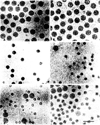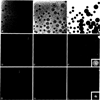Magnification calibration and the determination of spherical virus diameters using cryo-microscopy
- PMID: 2800042
- PMCID: PMC4167718
- DOI: 10.1016/0304-3991(89)90057-0
Magnification calibration and the determination of spherical virus diameters using cryo-microscopy
Abstract
The diameters of several frozen-hydrated, spherical viruses were determined using polyoma virus as either an external or an internal calibration standard. The methods described provide a reproducible and accurate way to calibrate microscope magnification. The measured diameters are in excellent agreement with respective measurements previously reported for aqueous samples at room temperature using X-ray diffraction methods. These results indicate that the native morphology and dimensions of biological macromolecules are better preserved in frozen-hydrated samples when compared with more conventional electron microscopy techniques such as negative-staining, metal shadowing or thin-sectioning.
Figures





References
-
- Backus RC, Williams RC. J. Appl. Phys. 1949;20:224.
-
- Sjostrand FS. Electron Microscopy of Cells and Tissues. Vol. 1. New York: Academic Press; 1967. p. 365.
-
- Cermola M, Schreil W-H. J. Electron Microsc. Tech. 1987;5:171.
-
- Luftig R. J. Ultrastruct. Res. 1967;20:91. - PubMed
-
- Wrigley NG. J. Ultrastruct. Res. 1968;24:454. - PubMed

